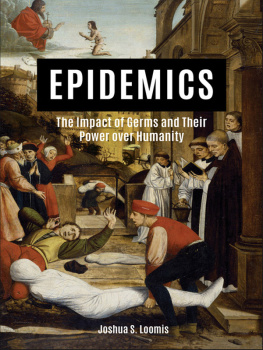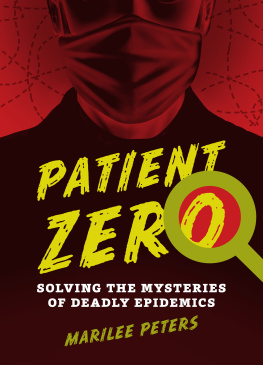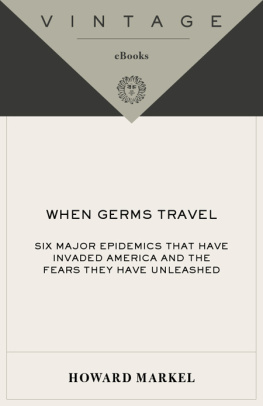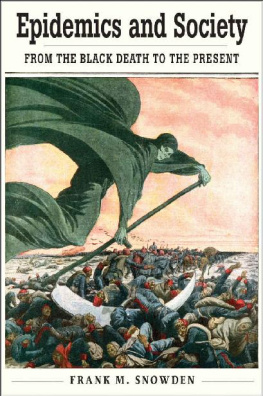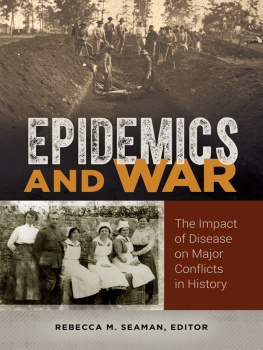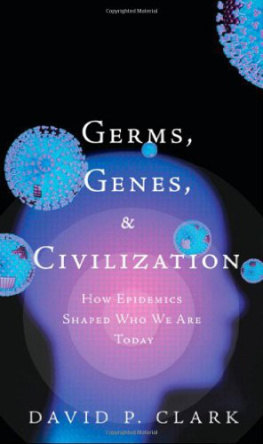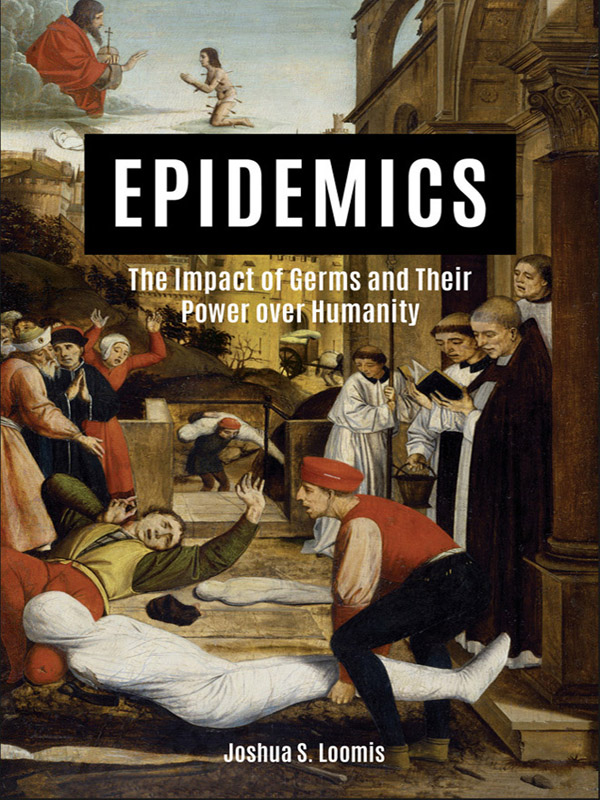Epidemics
Copyright 2018 by Joshua S. Loomis
All rights reserved. No part of this publication may be reproduced, stored in a retrieval system, or transmitted, in any form or by any means, electronic, mechanical, photocopying, recording, or otherwise, except for the inclusion of brief quotations in a review, without prior permission in writing from the publisher.
Library of Congress Cataloging-in-Publication Data
Names: Loomis, Joshua S., author.
Title: Epidemics : the impact of germs and their power over humanity / Joshua S. Loomis.
Description: Santa Barbara, California : Praeger, an imprint of ABC-CLIO, LLC, [2018] | Includes bibliographical references and index.
Identifiers: LCCN 2017043788 (print) | LCCN 2017045075 (ebook) | ISBN 9781440861437 (eBook) | ISBN 9781440861420 (print : alk. paper)
Subjects: LCSH: EpidemicsHistory. | Communicable diseasesSocial aspectsHistory.
Classification: LCC RA649 (ebook) | LCC RA649 .L68 2018 (print) | DDC 614.4dc23
LC record available at https://lccn.loc.gov/2017043788
ISBN: 978-1-4408-6142-0 (print)
978-1-4408-6143-7 (ebook)
222120191812345
This book is also available as an eBook.
Praeger
An Imprint of ABC-CLIO, LLC
ABC-CLIO, LLC
130 Cremona Drive, P.O. Box 1911
Santa Barbara, California 93116-1911
www.abc-clio.com
This book is printed on acid-free paper 
Manufactured in the United States of America
For Kim and Sophia
This book would never have happened without your love and support
Contents
Infectious agents have been with us as a species for as long as we have been a species. Despite having killed billions of people in every horrific way imaginable, most of us have just a superficial understanding of what infectious diseases are and how they have impacted us. The major reason for this is that few of us have personally experienced the devastating and uncontrolled spread of an epidemic disease in our population. We have thankfully grown up in an era when the vast majority of serious diseases can either be prevented or treated with proper sanitation, antibiotics, or vaccines. As a result, few people spend much time worrying about the possibility of being exposed to dangerous pathogens or having loved ones die from untreatable diseases. While this is an amazing testament to the progress we have made as a species, such advances have unfortunately lulled many into thinking that our technology has made us safe from future threats of new epidemics. It is a dangerous presumption to make, especially considering history is full of examples of unsuspecting populations being wiped out by killer diseases at a time when they thought they were protected in some way. For this reason, it is important that we take a look back at those diseases that have impacted us the most and examine what they have to teach us about who we are and where we are headed as a species.
The central purpose of this book is to look at the human story through the lens of epidemic diseases in order to explain how they have shaped our identity, altered the course of history, and changed how we interact with one another. This journey will take us through several thousand years of human history and traverse dozens of countries and every inhabited continent on Earth. The book will go beyond morbid accounts of disease symptoms and death statistics and tell the interesting and often forgotten stories behind what exactly made these diseases so awful for those who lived through them. The integration of science with history, sociology, religion, and other disciplines will provide the reader with a unique perspective that is not found in most other accounts of epidemic disease. In doing so, it will hopefully create a convincing argument that the history of humans cannot be accurately told without an including a discussion of these diseases.
Selecting which 10 epidemic diseases to include in the book was a difficult decision. The first thing that had to be done was to establish a set of criteria by which all diseases would be judged against. To be included in a book about the most impactful epidemic diseases of all time, it is obvious that a disease had to have killed or maimed a significant number of people. There was no magic number that was needed to make the cut; however, diseases with low morbidity and mortality rates were ruled out because they usually fail to cause any kind of panic. Second, the disease had to have had some historical significance or induced some major change to how we live or behave. This could include epidemics that altered the course of wars, toppled empires, sparked major leaps in technology, and even changed the sequence of the human genome. Finally, the disease had to be broad in its scope, either persisting for long periods of time or affecting people of different cultures in different places. Since smaller outbreaks in defined locations usually do not produce lasting changes on a global scale, they are somewhat less appropriate for this book.
With these limited criteria in hand, I set out to construct a list of the 10 worst epidemics to ever strike our population. There are certain diseases like measles, syphilis, leprosy, and typhoid fever that just missed the cut despite being highly influential in their own right. In fact, nearly any one of these four could have been substituted for polio or yellow fever without losing much in terms of content. However, it was ultimately determined that included diseases were just a bit more impactful and destructive than the others mentioned above. Some of these, like smallpox and plague, were chosen because of the immense effects they had on our ancestors who lived long ago, whereas others, like HIV and polio, were picked because of their role in shaping modern society. In the end, all 10 of the diseases that were selected had an important story to tell us about what it means to be human.
Upon reading the book, it will become readily obvious that it does not present an exhaustive history of every known pathogen. So much amazing scholarship has taken place over the last several decades that each chapter could be expanded into several books of their own. Indeed, there have been many published recently that provide the fine details of just one disease or even a single substory within a broader epidemic. While such books can obviously delve deeper into a topic than what I am able to do with a chapter, they largely fail to reveal big picture relationships that exist between epidemics and humans. For this reason, I chose to broaden the scope of the book and write in it a way that provides the reader with a more holistic understanding of epidemic disease.
Although they are tens of thousands of times smaller than the human hosts they infect, microscopic germs can produce dramatic and permanent effects on both the individual and populations as a whole. We experience the negative impacts of these parasites throughout our liveswe get the sniffles, wake up with nausea, and suffer through bronchitis. In most cases, we go to the doctor for a weeks worth of medication and our immune system eventually defeats the infection. Most of us alive today have never experienced the devastating and uncontrolled spread of a disease in a population and the fear and hopelessness that it produces because we have grown up in the age of antibiotics, vaccines, and modern medicine. However, for most of human history (and still in many parts of the world), pathogens have run amok in our population and caused significant changes to how we interact with one another. Catastrophic epidemics such as the Black Death of the 14th century or the 1918 influenza epidemic almost always produce lasting changes that can be felt hundreds or even thousands of years after the epidemic has ended. The following chapters of this book will review 10 of the most deadly and influential epidemics throughout history and examine their cause, spread, and long-term impacts on humanity.

